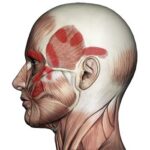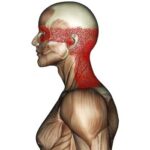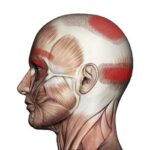The suboccipital muscles are four small muscles located at the bottom of the skull. Though these muscles are small, they can cause and contribute to headaches and eye pain and often cause migraine headaches.
Where are the suboccipital muscles?

- Obliquus capitis inferior
- Obliquus capitis superior
- Rectus capitis posterior major
- Rectus capitis posterior minor
What Movements Do The Suboccipitals Control?
- Turns the head to the side
- Tilts the head to the side (ear to shoulder)
For detailed anatomy information: Suboccipitals Anatomy
Advertisement
What pain and symptoms are associated with the suboccipital muscles?

Trigger points in the suboccipital muscles cause pain that makes the entire side of the head hurt. The pain feels as if it is deep in the skull, which is also a symptom of many migraines. You may experience a band of pain that starts in the back of the head and extends into the eye. There is often a band of very intense pain just behind the ear.
Another common symptom of trigger points in the muscles is stiffness in the neck without pain. You have limited motion in the neck but do not feel pain while turning or bending the neck.
TWD Recommends
 Suboccipital muscle tightness and pain respond well to hot and cold treatments. The Huggaroo Neck Wrap treats the neck, top of the shoulder, and upper back. Use cold for migraines and whiplash injuries. Use heat for tension headaches and relaxation.
Suboccipital muscle tightness and pain respond well to hot and cold treatments. The Huggaroo Neck Wrap treats the neck, top of the shoulder, and upper back. Use cold for migraines and whiplash injuries. Use heat for tension headaches and relaxation.
What causes trigger points in the suboccipital muscles?
TWD Recommends
Do You Have Headaches That Radiate From Deep In The Head? A Stiff Neck But No Pain?
 These symptoms point to the suboccipital muscles. The Craniocradle was developed to treat headaches and stiff necks. The cradle applies pressure to the neck muscles while providing gentle traction to the neck. Use for 5-10 minutes and feel a reduction in pain and stress. You can also use the cradle to treat other body areas, including the low back and hip areas. An instruction booklet is included in the package.
These symptoms point to the suboccipital muscles. The Craniocradle was developed to treat headaches and stiff necks. The cradle applies pressure to the neck muscles while providing gentle traction to the neck. Use for 5-10 minutes and feel a reduction in pain and stress. You can also use the cradle to treat other body areas, including the low back and hip areas. An instruction booklet is included in the package.

Suboccipital Muscles Trigger Point Treatment
The suboccipitals are relatively easy to self-treat once you learn to find the muscles. The Trigger Point Therapy Workbook is an excellent resource to learn how to find and treat trigger points. Though it takes time and some patience to learn the feel of TrPs, it is time well spent. Once you know, you will be able to self-treat muscle pain throughout the body.
Biofreeze Pain Relieving Gel is an excellent pain-relieving gel, and I recommend it for those who have sudden onset muscle pain or recent injuries. It is better than warm therapy gels and creams for recent injury pain as it cools the area much like ice and does not promote swelling. Biofreeze is recommended for those who have had a recent neck muscle injury, including whiplash or sudden onset pain. Rub Biofreeze into the upper back, shoulders, and back of the neck, going up to the skull base and over behind the ears.
Sombra Warm Therapy Pain Relieving Gel is a pain-relieving gel that I use personally and professionally in my massage therapy practice. Unlike other over-the-counter heating creams, it provides warmth without burning heat. Applying Sombra to the back of the neck, up behind the ears, and along the skull base will help relax the muscles and provide pain relief.
TWD Recommends
 Does your pillow support your head and neck?
Does your pillow support your head and neck?
Sleeping without proper head and neck support is sure to aggravate neck and shoulder muscles. The Sweetnight Pillow has adjustable filling and is highly recommended for its neck support.
Interesting facts about the suboccipital muscles
- The obliquus capitis inferior, obliquus capitis superior, and the rectus capitis posterior major are the muscles that make the borders of the suboccipital triangle.
- Suboccipital pain feels like it is deep inside the head. The pain is referred to as ‘ghost pain’ because the pain is hard to pin to a specific location and is hard to define.
Clinical diagnoses to which the suboccipital muscles symptoms may contribute:
- Headaches
- Temporomandibular Joint Dysfunction
- Sinusitis
- Eye Strain
- Food Allergies
- Concussion
- Post Concussion Syndrome
- Toothache
- Mastoiditis
Advertisement
Other muscles that should be considered and examined in conjunction with the suboccipital muscles:
- Longus Colli
- Longus Capitis
Satellite trigger points associated with the muscle:
- Trapezius
- Sternocleidomastoid
- Levator Scapulae
- Longus Colli
- Longus Capitis
TWD Recommends
 I often recommend the Neck King Massage Tool For Neck and Back to my clients who suffer from headaches, migraines, and stiff necks. The Neck King works on trigger points and pressure points to help relieve muscle tension and pain. The secret to using the Neck King is to follow the directions carefully and slowly build up the time spent using the tool. For many first-time users, the tool is too hard to use comfortably. Folding a hand towel and laying it over the Neck King will help ease the discomfort. It works exceptionally well on the muscles at the base of the skull. This tool has helped me, and many of my clients relieve headaches, sore, stiff necks, and upper back strain.
I often recommend the Neck King Massage Tool For Neck and Back to my clients who suffer from headaches, migraines, and stiff necks. The Neck King works on trigger points and pressure points to help relieve muscle tension and pain. The secret to using the Neck King is to follow the directions carefully and slowly build up the time spent using the tool. For many first-time users, the tool is too hard to use comfortably. Folding a hand towel and laying it over the Neck King will help ease the discomfort. It works exceptionally well on the muscles at the base of the skull. This tool has helped me, and many of my clients relieve headaches, sore, stiff necks, and upper back strain.
Find additional muscles that may contribute to these symptoms:
EAR | EYE | HEADACHE | POST CONCUSSION SYNDROME | SINUS PAIN | TEMPOROMANDIBULAR DISORDER | TMJ | TOOTH PAIN




